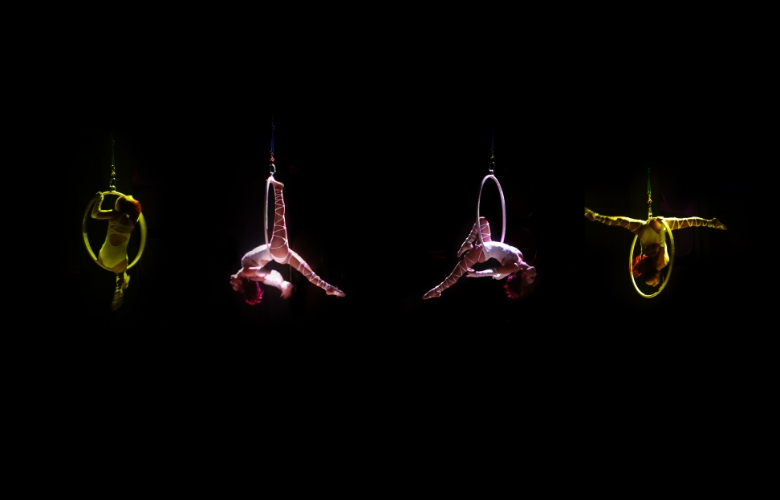
Top 5 Concepts for Performer Injury Prevention
Acrobat or Actor, Clown or Contortionist, Dancer or Diver – your body is your tool, your asset, and it’s the only one you have. It’s important to both improve and protect it to succeed long term.
As a Performing Arts Physiotherapist, I like Performers to think about the way they use their body as an “activity triangle”. The three sides of the triangle are:
Technique, Performance, & Conditioning
To help avoid injuries, it is important this triangle is in balance. If all your training is technical, you are at risk of not having the strength, flexibility, power or endurance to prevent injury. If your staging, choreography or on-stage performance is dominating your week, then you may be compromising technique or skill development.
When you balance your strength and conditioning; technique training and skill acquisition; and on-stage demands, you are more likely to stay injury free.
Of these three elements, Conditioning (specifically exercises focused on addressing previous injuries) is the most frequently neglected part of this triangle
Many people think about muscles being either ‘too tight’ or ‘too weak’. A better way to understand how the body works, it to consider muscle balance.
Muscles work together as agonists (shortening to contract), antagonists (lengthening to return a joint to its resting position), or as synergists (muscles working in concert with other muscles to control movement at a joint). Muscles act around individual joints, across multiple joints, and in links of connected myofascial chains to produce effective human movement.
It is important that there is a balance of resting muscle tone, muscle strength, joint & muscle flexibility, and motor control around joints to move efficiently. Imbalances can occur in a number of ways:
Improving muscle imbalances often requires an initial awareness better of movement patterns – then focusing on incorporating corrective exercises to strengthen, lengthen, or improve control of movement.
Incorporate muscle balance and injury prevention focused exercises into your warm-ups and regular injury prevention conditioning to help lower your risk of injury today!
The human body is fantastic at responding to demands of regular and increasing workload. However, it takes time to build technique, strength, flexibility, and control – sometimes it takes weeks, sometimes it takes years.
A great way to make sure you stay injury free whilst you are learning new skills and increasing performing workload is to Periodise Your Workload.
Firstly:
Have a close look at the next 3 to 6 months of performances, and consider the training and staging demands required to make these happen.
Secondly:
Break your calendar into manageable periods: ideally 4 to 6 week blocks of time. In each block, incorporate three phases: and an Overload phase, a Maintenance phase, and a short Taper (reduced workload phase). If you can maintain your workloads steady at 80% to 130% of your average (100%) weekly workload, in these 3 phases; studies have shown you can accomplish a sweet spot of training and effectively lower injury risk
Thirdly:
Measure and track your workloads over these blocks of time. Plan and be specific in your training, conditioning, and performance – accomplishing each of the overload, maintenance and taper phases. Make use of wearable devices where possible (eg smart watches, smart phones, sleep trackers). Recognise the effect of non-performance activities (like holidays, hobbies or parties); and work smart to hit that sweetspot of 80% to 130% activity loads to reduce your injury risk.
A proper warm-up can reduce injury risk by between 30% & 70%!
Good warm-ups increase blood flow to your body parts, start your ‘metabolic body’, load your muscles & joints gradually, prepare movement patterns & techniques, and improve mindfulness.
So what is an effective warm-up?
Your own best warm-up depends on what training or performance you are preparing for. But all good warm-ups include:
Good preparation for performance also includes early organisation of your tape, makeup, wardrobe, equipment & props – allowing you to focus your mind and body towards the role you’re playing.
So you’ve prepared your training & performance calendar, done your strength and conditioning, worked hard at injury prevention, and risen to the occasion at those gala performances…. what now? It’s time to recover!
Recovery is a vital part of training. It is during recovery that our bodies make the physical adaptions that we have trained for… and it is during rest that our brains are able to transform new movement patterns (like new techniques or choreography) into long term memories.
To recover properly you’ll need to:
The number 1 way to rest your mind and body is SLEEP !
Sleep is a full topic all of its own ….
Sleep is the number one most powerful tool to help you recover, and to build your body & mind for your next best performance. Sleep is a vital for injury recovery, strength adaption, cardiovascular replenishment, mental health and overall well-being. Make your 8+hours of sleep per night a non-negotiable part of your high-performance plan.
Love to write or have something to say? Become a contributor with TheatreArtLife. Join our community of industry leaders working in artistic, creative, and technical roles across the globe. Visit our CONTRIBUTE page to learn more or submit an article.
© 2021 TheatreArtLife. All rights reserved.

Thank you so much for reading, but you have now reached your free article limit for this month.
Our contributors are currently writing more articles for you to enjoy.
To keep reading, all you have to do is become a subscriber and then you can read unlimited articles anytime.
Your investment will help us continue to ignite connections across the globe in live entertainment and build this community for industry professionals.